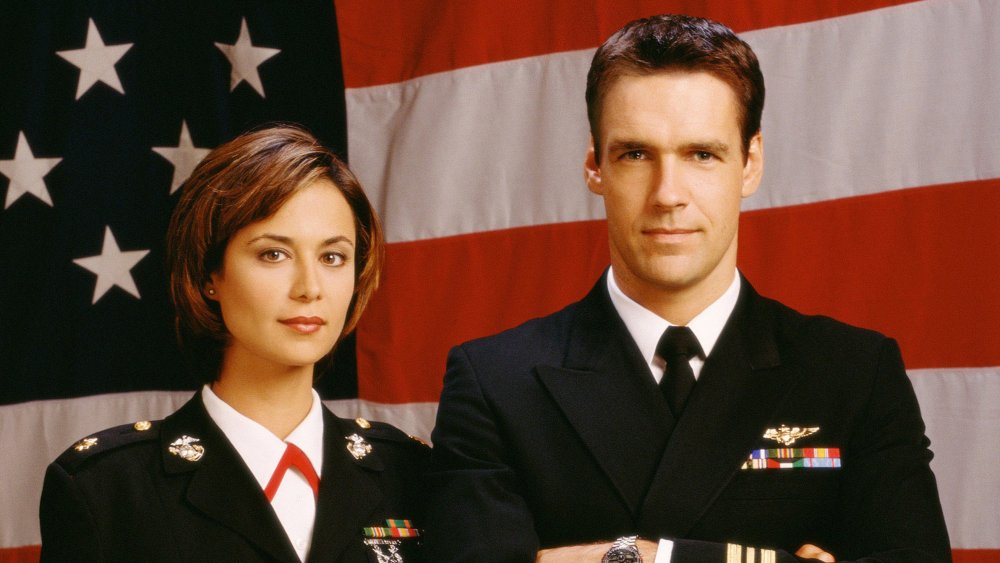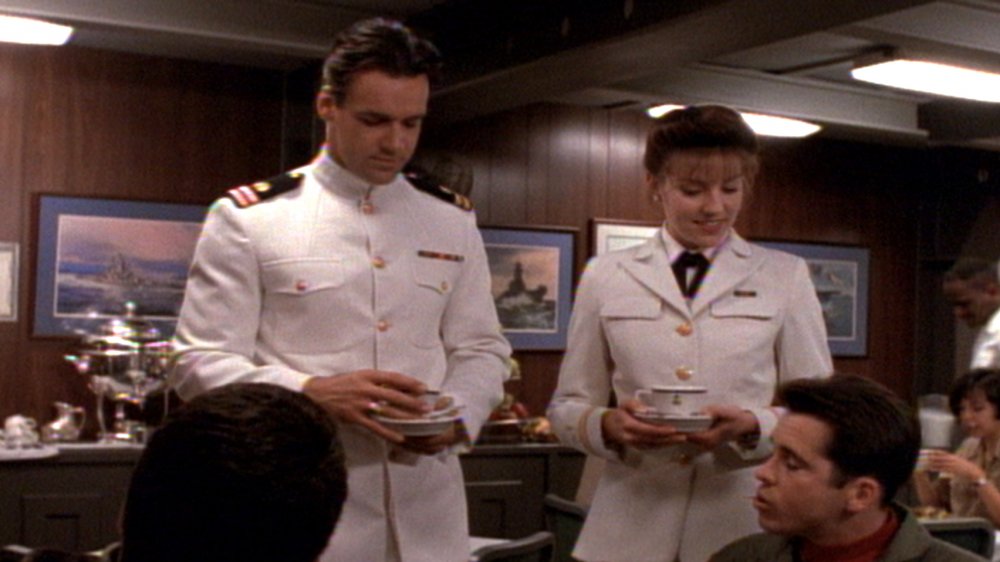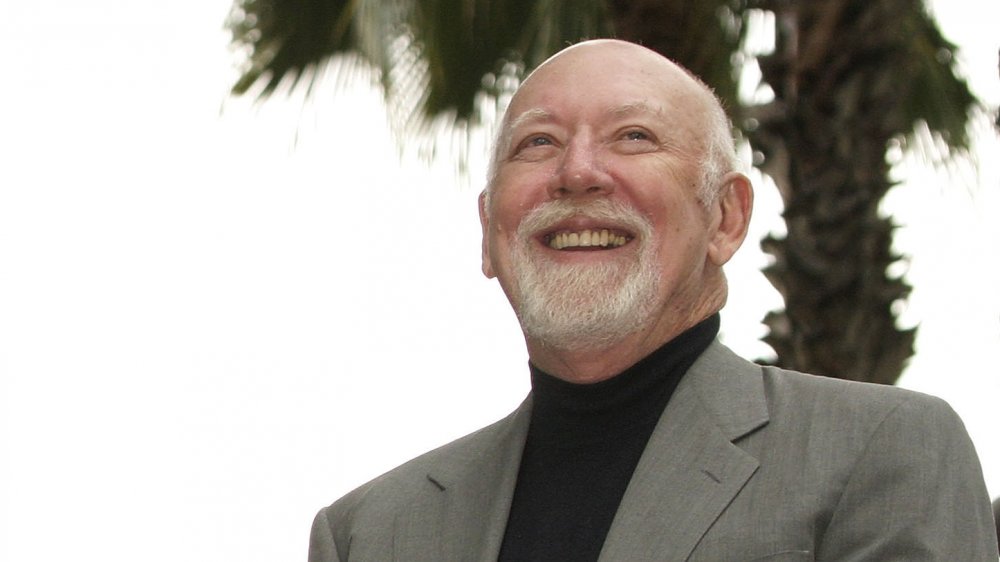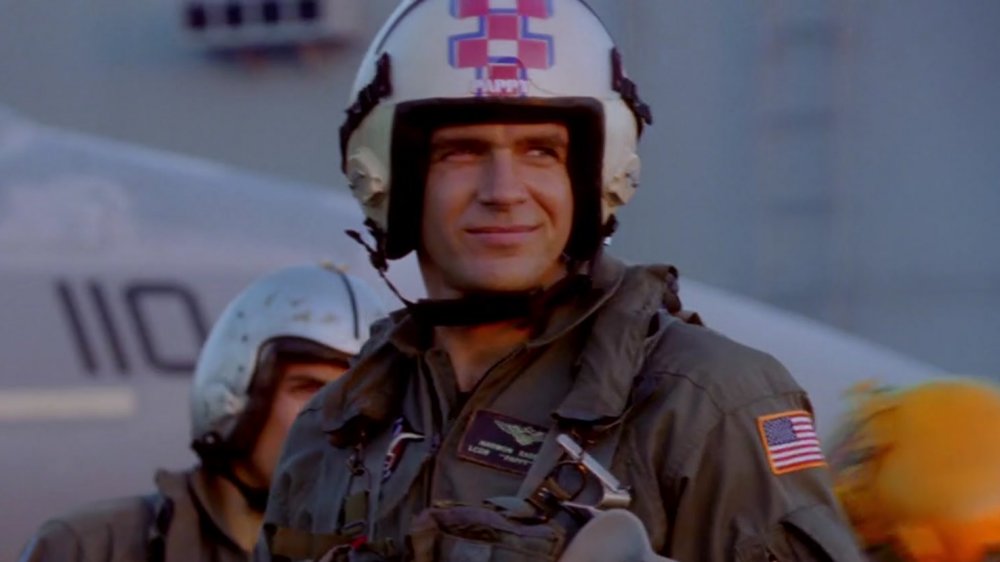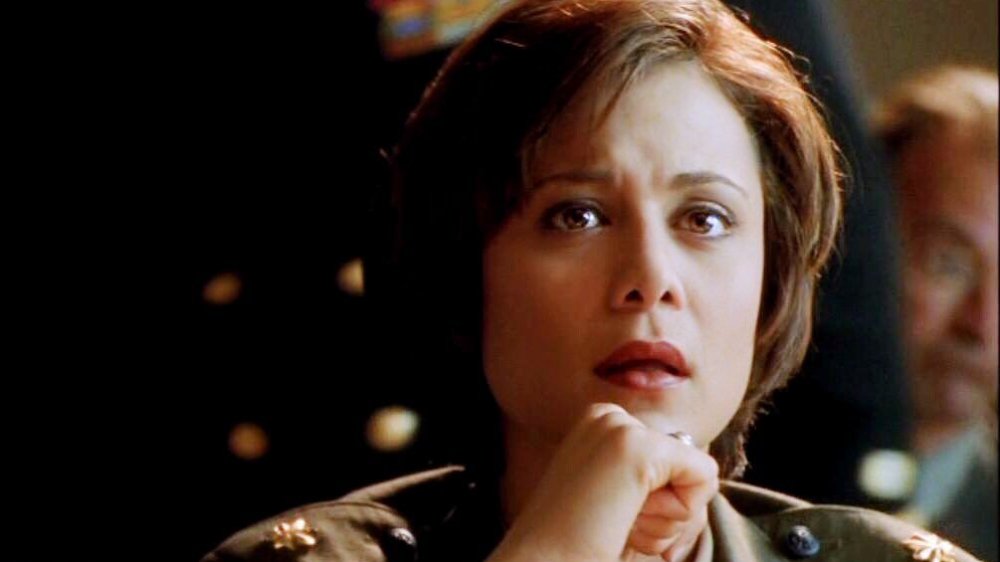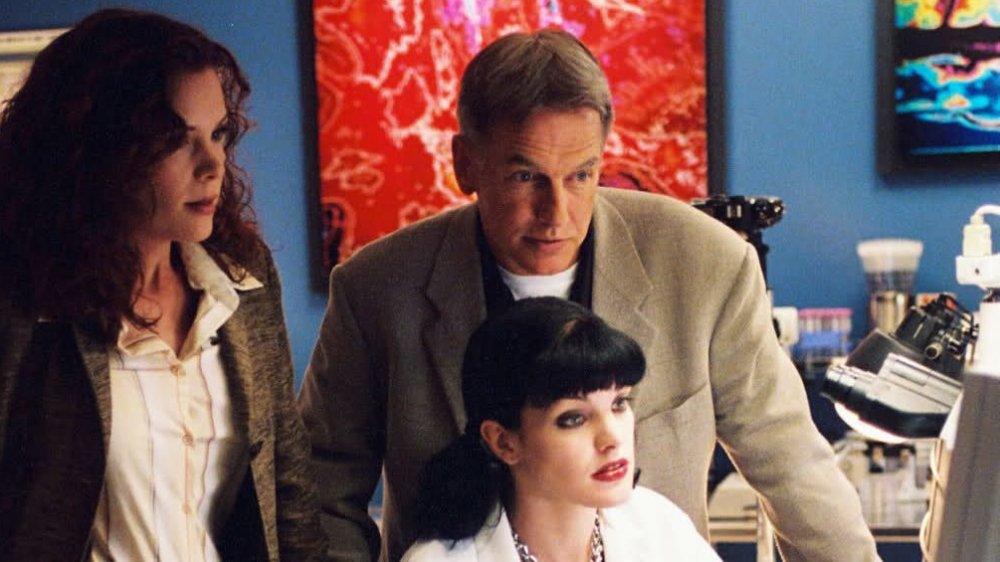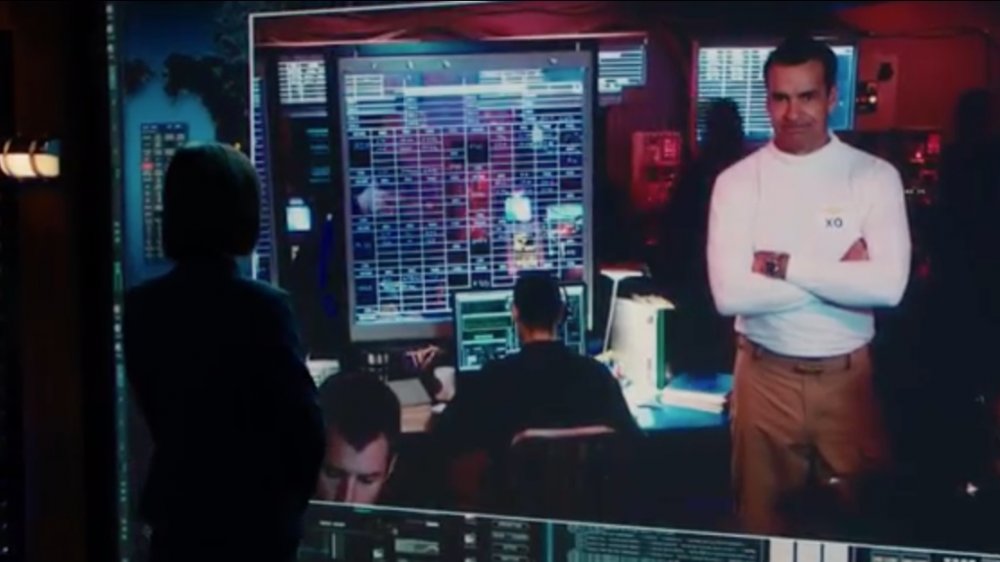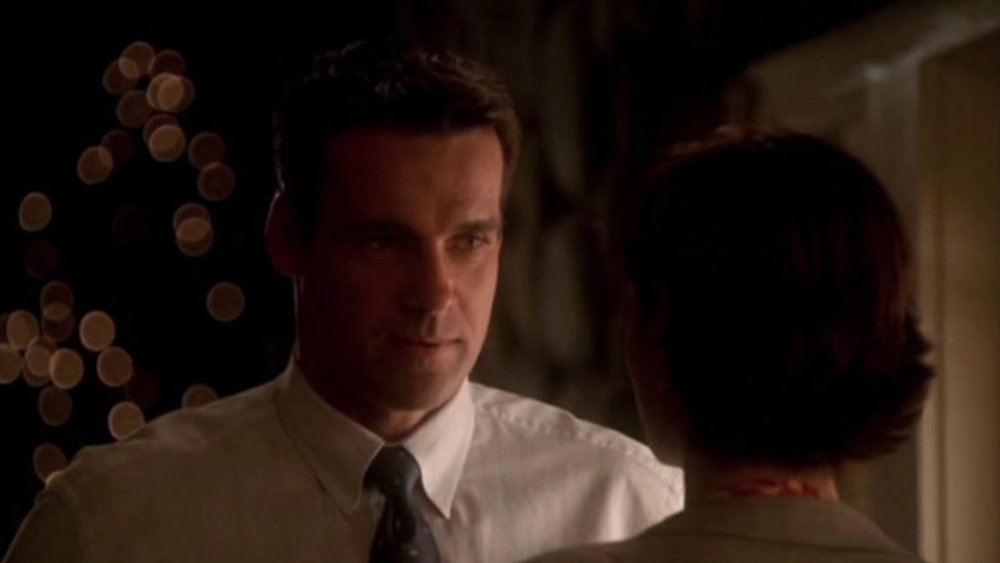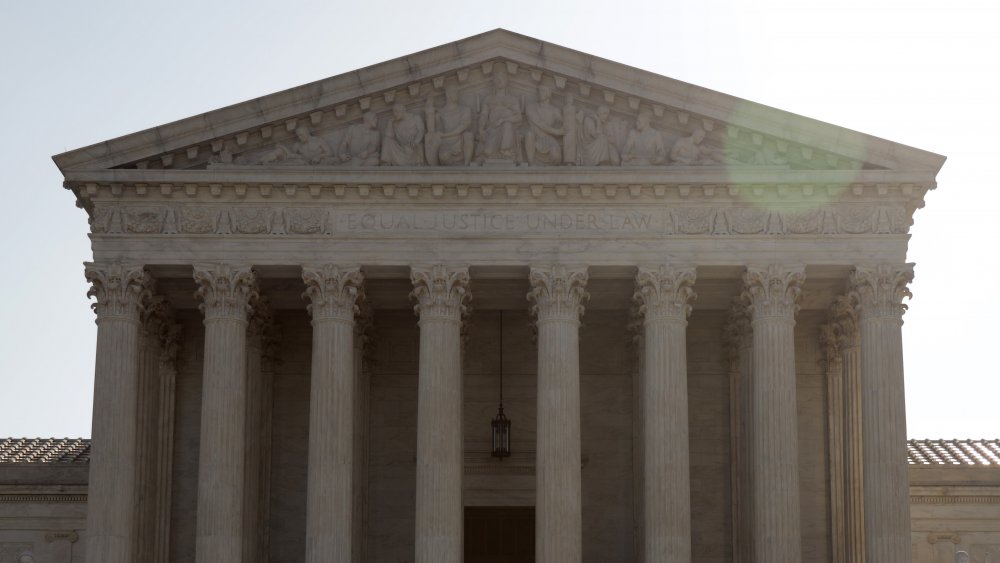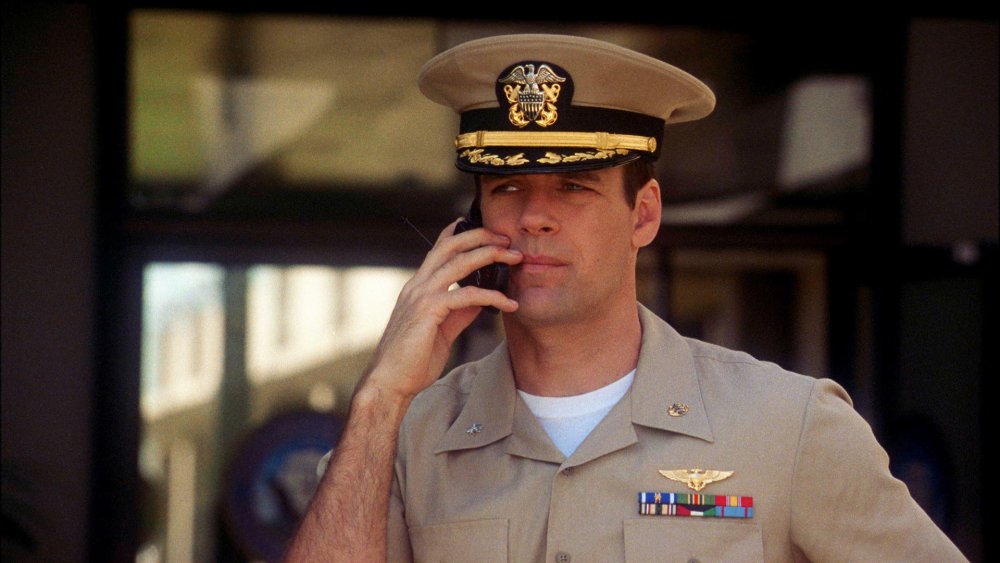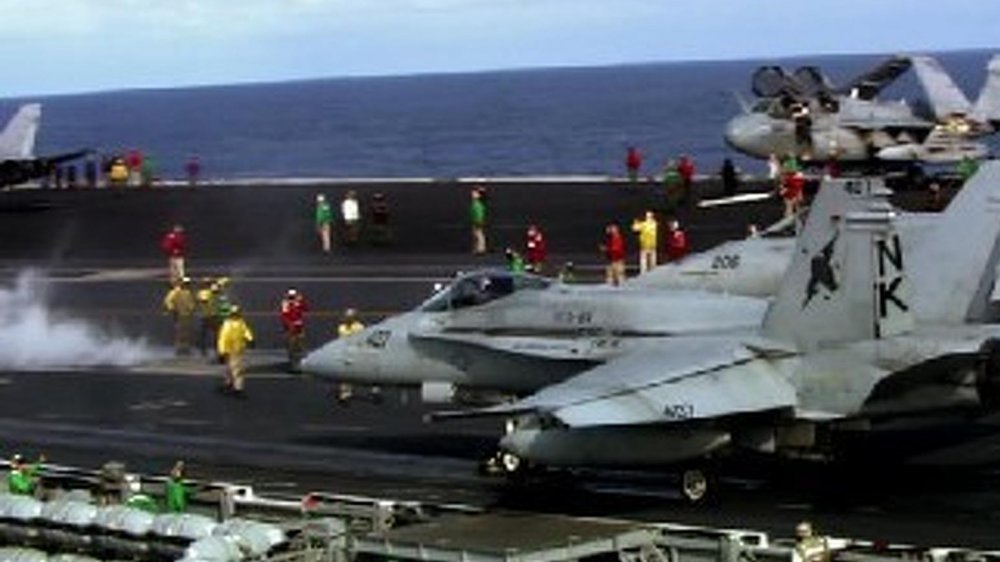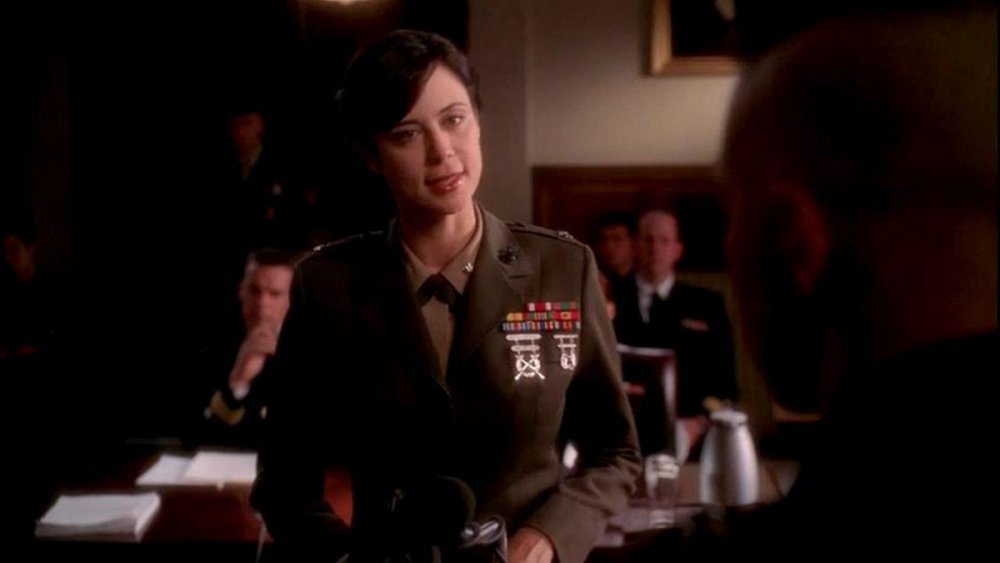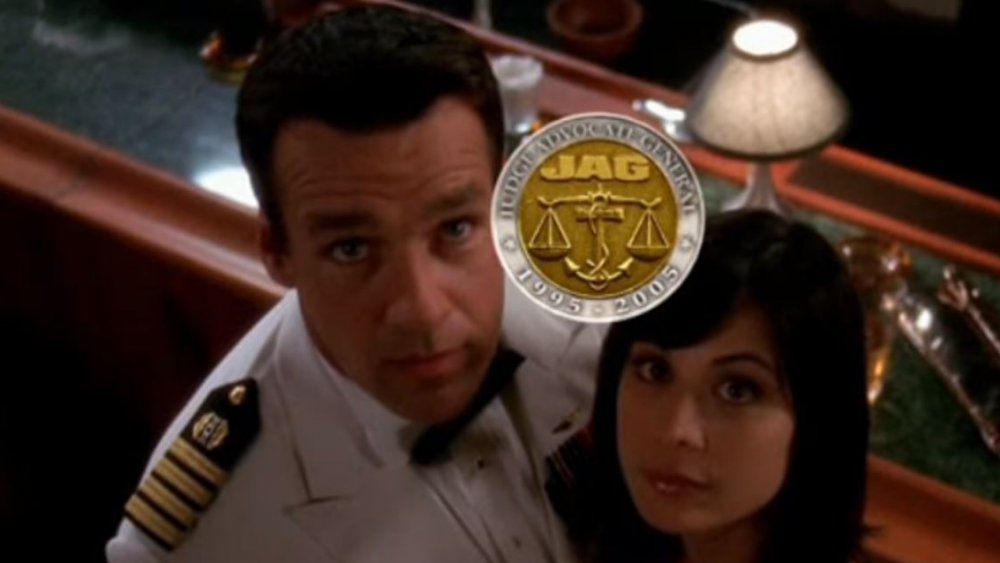The Untold Truth Of JAG
Before the NCIS team was dealing with kidnapping, spies, and assassinations, JAG was hauling bad guys into military court to face justice.
In case it's been a while, here's a reminder: JAG stands for Judge Advocate General. In real life, this is the part of the military that involves more paperwork than action, since judge advocates work on the judicial side of things. But JAG still finds plenty of ways to squeeze in exciting moments, including hijackings, international political crises, training gone wrong, a missing father, and a whole lot of murder.
Creator David Bellisario's clear visions of his leading characters are apparent from the first episode. Harmon 'Harm' Rabb Jr. is the strong but sensitive naval aviator-turned-lawyer with a dry sense of humor, prone to occasional righteous violence. He meets his match in season two in the form of Sarah 'Mac' Mackenzie, a Major in the Marines with a troubled history that includes neglectful parents, teenage alcoholism, and a stint in a high-end law firm.
JAG's chemistry, creativity, and cleverness still shine as brightly as the day the show debuted. From its unlikely renewal to its surprisingly long afterlife, this is its story.
JAG came back from the dead
The JAG team might be responsible for convicting murderers, but the show was very nearly killed off itself.
The first season of JAG aired on NBC in 1996. Well, some of it did: Although 22 episodes had been made, the network only broadcast 21. Then-NBC president Warren Littlefield told show creator Don Bellisario that he didn't think JAG would make it through another season, but that he was welcome to take it to CBS if he thought he could get it to work there.
Bellisario and distributor Paramount did just that. They convinced CBS to pick up JAG for the middle of the season, airing on Friday nights. Littlefield later admitted that he thought this was unlikely to work at the time, but CBS turned out to have a much better understanding of JAG's appeal. Then-head of CBS Les Moonves (who resigned in 2018 after allegations of sexual misconduct) moved JAG's season three to Tuesday nights. Moonves said that he felt JAG was "better for us creatively" than for NBC, possibly referring to CBS's slightly older audience. And like the Navy jets on screen, JAG took off: It was soon beating time slot rivals including World's Scariest Police Chases on Fox, ABC's Home Improvement, and NBC's big bet Mad About You.
Don Bellisario was inspired by the first women on combat ships
In 1994, Bellisario was facing what many Hollywood writers would label a champagne problem: It was the first time in a few years that he didn't have a show on the air. So he started writing and discarding ideas — "wherever my mind took me" — hoping to find a hit.
Meanwhile, the first 500 women to serve on combat ships in the US Navy were reporting for duty. This historic event gave Bellisario a vision for a scene: Two F-14s, one with a female Radar Intercept Officer (RIO) whose Commander, Air Group (CAG) was determined "to put her through her paces." In case you're lagging behind on your JAG-watching, a RIO, now called a Weapon Systems Officer (WSO), is the person who does all the planning for the pilot and (wo)mans the weapons: See Goose in Top Gun.
The similarities between JAG and that film are not coincidental. Bellisario pitched JAG to NBC as a combination of Top Gun and another Tom Cruise movie, this one focused on battles in the courtroom rather than the sky. "I sold it to NBC as a kind of combination of Top Gun meets A Few Good Men," he said. And a few good women.
David James Elliot nearly didn't get to play Harm
Picturing anyone other than David James Elliot as charming, daring judge advocate Harmon 'Harm' Rabb Jr. is almost impossible after watching him own the role for 10 years. But Don Bellisario has admitted that he put Elliot through four auditions before naming him as the series' lead. "He was always this big, tall, good-looking [guy] and a good actor, but I was looking for a certain style of humor," Bellisario said. It was on that fourth audition that Elliot locked in to what the creator wanted humor-wise — presumably Harm's air of wry amusement — and that's when he got the part.
As for Elliot, he's said that what drew him to the role of Harm was that he's a tough military guy who also has an emotional side and back story. "I had the challenge of making him a real, breathing person in this hard world of the military ... to find the humanity in this rigid system," he said. Like other JAG actors, Elliot also got the chance to play additional characters. He appears in flashbacks as Harm's father, Harmon Rabb Sr., who went MIA in Vietnam on Christmas Eve 1969, and as a young lieutenant caught up in the Battle of Iwo Jima during a flashback episode to World War II.
Catherine Bell was only supposed to have three lines
Catherine Bell became beloved to JAG fans as the sharp-tongued and resilient Marine Major Sarah 'Mac' MacKenzie — but Mac wasn't the first character she'd played on the show. In the first season, Bell plays Lieutenant Diane Schonke, an old flame of Harm's, who is murdered by an unidentified stalker. Bell's character is only in the episode for the first five minutes (alive, anyway) but her unsolved murder haunts Harm until he solves it in season three.
The first time Harm meets Mac — the doppelganger for his dead love — in the season two opener, he is reminded of Schonke. Unfortunately, American viewers missed that detail, because the episode that features Schonke — the last of season one — didn't air on US TV until 1999, three years after the rest of the first season.
But it wasn't just fate and the chance to tell a doppelganger story that saw Bell return to JAG. When she heard that Bellisario was looking for a new female lead for season two (replacing Andrea Parker, who had another commitment) she wrote him a letter explaining why she would be perfect for it. Bellisario said he remembered her as a good actress, and thought it would be interesting to have a character who looked like Schonke come back to mess with Harm's head. He still put her through a fairly grueling audition process: "Six callbacks later, I got the role," Bell said.
This JAG spin-off is the most watched drama on TV
If you can't get enough of watching good-looking people investigate and prosecute Navy-related crimes, you probably already love NCIS. While the judge advocates do their fighting in the courtroom, the officers of the Naval Criminal Investigative Service are the ones on the ground (and sometimes boats), detaining suspects and stopping the occasional terrorist.
NCIS is the most watched scripted drama on TV, supported by two successful spin-offs set in Los Angeles and New Orleans — and all of it came from JAG. Two episodes of JAG season eight serve as so-called "backdoor pilots," introducing NCIS cast members Mark Harmon, Michael Weatherly, Alan Dale and Pauley Perrette. But if you ever run into Bellisario, don't call NCIS a spinoff.
Bellisario was aware of the investigative branch of the Navy's internal crime-fighting system when he created JAG, but didn't immediately bring them into the series because he thought it would be confusing. When he created NCIS, he asked then-CBS head Les Moonves to advertise the shows separately, because he was trying to reach a different audience. "This is gonna be a hipper show for a younger audience ... you tie it to JAG and the young people are gonna go, 'This is just another version of JAG' and they're not gonna watch it," Bellisario explained. Moonves ignored this advice, but it doesn't seem to have hurt NCIS in the long term.
NCIS: Los Angeles hosted a pivotal JAG reunion
The JAG episodes that kicked off NCIS sparked a long history of crossovers. John M. Jackson's Rear Admiral A.J. Chegwidden makes a one-off appearance in an episode of NCIS, then has a longer arc in seasons eight and nine of NCIS: Los Angeles. And it is in season 14 of NCIS that we learn that Bud Roberts — the most likeable lawyer on TV — has been promoted to Captain.
But the most important JAG-meets-NCIS crossover was the reunion between JAG's will-they-won't-they couple Mac and Harm. The last scene of JAG shows the newly-engaged pair tossing a coin to determine which one would retire to follow the other. It took 14 years to find out the result.
In the season 10 finale of NCIS: Los Angeles, Mac and Harm reconnect — to their surprise — over a video call. It turns out that they did get married and moved to San Diego for Mac's work, but Harm returned to service and the relationship didn't work out.
However, there is a spark of hope. Both characters are featured in the season 11 premiere of NCIS: Los Angeles, where they have an in-person reunion, and there have been some hints that things aren't over yet. Rumor has it the two are getting ready to lead their own spinoff — let's hope it doesn't take another decade and a half to find out.
David James Elliot was dropped from JAG
David James Elliot was JAG's anchor (pun intended) from the show's start. So when it was announced midway through season 10 that he wouldn't be returning, it wasn't just the actor's fate that seemed to be in jeopardy.
Bellisario tried to play down his leading man's departure, saying that Elliot's contract was up and "[they] had to cut costs." He said that the show had deliberately used Elliot less and less in his final season, and that the actor had gotten the hint that they weren't up for renegotiating his return. (In contrast, Elliot's manager said that his client had requested another season but received no response.)
Despite the awkward he-said-he-said, it seems like there was no bad blood between the actor and the show that put him on millions of people's TVs. Elliot had apparently already "made a lucrative deal" with rival network ABC. He played major roles on a few short-lived ABC shows — Scoundrels in 2010, GCB in 2012, and Secrets and Lies from 2015 to 2016 — and was in a couple of episodes of Mad Men.
More recently he's worked on shows from streaming services, appearing in YouTube's Impulse and Netflix's Spinning Out, both of which were cancelled in 2020. JAG, meanwhile, didn't make it back to air after Elliot left — but his appearances on NCIS: Los Angeles suggest he's not ready to say goodbye to Harm just yet.
Another JAG crossover didn't fare so well with viewers
While NCIS went on to garner its own fanbase and produce multiple spinoff series, another JAG crossover series failed to find an audience. Also created by Bellisario, First Monday focused on the US Supreme Court: The title is a reference to the fact that the Court traditionally begins every new term on the first Monday in October. Starring Joe Mantegna, James Garner, and Camille Saviola, the pilot aired in January 2002 and is most notable for featuring Kaley Cuoco in a small part.
We already know that Bellisario likes a controversial criminal case. But First Monday appears to have been inspired by an event that needed no dramatization: The contested 2000 US Presidential election. The election brought the Supreme Court to the forefront when the Justices reached a controversial 5-4 decision not to recount votes cast in Florida, effectively handing victory to George W. Bush.
First Monday wasn't the only show that tried to capitalize on the public's renewed interest in the Supreme Court: In March 2002, ABC released a similar drama, The Court, starring Sally Field. But by then, the public had gone back to not really caring about the legal system, and both series were quickly cancelled. However, one character survived: Senator Edward Sheffield appears in 11 episodes of JAG.
Don Bellisario wanted to counter negative portrayals of the military
For Bellisario, the military setting is personal. He served in the Marines from 1955 to 1959 and has spent his TV-making career trying to show a more nuanced side of the military than is often portrayed on screen. In his first hit show Magnum P.I., Bellisario intentionally showed Vietnam veterans who defy stereotypes, successfully integrating back into society. As Bellisario put it, "anytime you saw a Vietnam vet in television, he was an alcoholic, a druggie, a shooter in a tower, a wife beater, a killer, [or] insane. And you never saw a positive image."
With JAG, Bellisario was determined to show that the military is about more than violence and combat. Although the show has its bad guys (and women), Bellisario made sure to show that most people in the military are in the fight to make the world a better place. He took this part of the job so seriously that he worried that the end of JAG would mean audiences would see nothing but negative depictions of military life.
Much of the cast also did their homework on Naval protocol. David James Elliot told the New York Times that he'd prepared for the role of Harm by reading up on military etiquette — and that it was even more mind-blowing than the ships and planes he found himself starring alongside.
JAG got inventive to get those incredible shots
Bellisario and his team wanted the series to look as close to a real Naval operation as possible, complete with aircraft carriers, fighter jets and stunts. "One episode we had tanks — we actually got a tank from the military and ran it up and over a car," recalled Diamond Farnsworth, the stunt coordinator for every episode of JAG and 17 seasons of NCIS. And if you think tanks are impressive, look up. George Tuers was prop master for all 10 seasons of JAG and four seasons of NCIS. He said that in between shooting the first and second seasons, Bellisario asked him to find an F-14 Tomcat. Somehow he did: The plane was so heavy the crew had to take it apart, move it into position, and reassemble it.
However, since JAG's Naval-sized vision didn't have a Naval-sized budget, the team couldn't always whip up a fighter jet or an aircraft carrier, let alone crash them. Eventually, the initially resistant Navy helped out, allowing the production to use stock footage. And the JAG team got creative with a little help from production company Paramount, who gave them access to a library that included shots from films including The Hunt for Red October, Flight of the Intruder and Top Gun. If they ever do make that oft-teased JAG reboot, it looks like moments in the new Top Gun: Maverick might offer even more impressive shots to use.
The Navy was not on board with JAG at first
Although JAG often shows the positive side of the Navy, a Naval courtroom drama has to feature seamen behaving badly. The Navy was understandably very opposed to a show that aired its dirty laundry in public — at least initially — especially since many of the fictional cases were based on real life crimes. Bellisario also pointed out that when JAG first aired in 1995, the Navy was still reeling from the Tailhook scandal.
However, the relationship between the fictional and real organizations eventually found its way into smoother waters. It helped that, as Bellisario said, "every Tuesday the show would run, and every Wednesday the enlistment would spike." Bellisario's aims tended to line up with those of the Navy: "In the end ... the Navy does the right thing — bad people are punished, and good people are rewarded," Commander Bob Anderson, the Navy's Hollywood liaison, told the LA Times in 2005.
As well as providing footage to help the show look good, the Navy allowed JAG to film on restricted properties and reviewed the scripts, providing feedback on military terms, uniforms and protocol. Even the Pentagon sometimes got involved. But the Navy refused to cooperate on episodes it fundamentally disagreed with, including one where a submarine accidentally drops a nuclear round. Bellisario made the episode anyway.
JAG was canceled so abruptly the ending was rushed
In 2005, after 10 seasons on air, JAG's future was looking uncertain. The show had always had a cult following, but not among the 18-49 age demographic beloved by advertisers (and therefore network executives). 10 years in, that loyal audience was looking even older. The departure of David James Elliot also didn't bode well.
By the end of the 10th season, Bellisario and his writers were writing episodes without knowing if they would be coming back. Bellisario has said that he kept asking CBS if they would get another season, because he wanted to give JAG a fitting ending after a decade on air. But the network was consistently cagey about the show's fate. The last episode aired on April 29 2005 and the show didn't come back.
Despite his frustration at not being able to go out with a big enough bang (and maybe some more F-14s) Bellisario has said he is pleased with the cliffhanger ending he left JAG fans with — that coin toss — for 14 years. With Mac and Harm still drawing viewers to JAG's descendant shows, we might yet find out how the story really ends.
